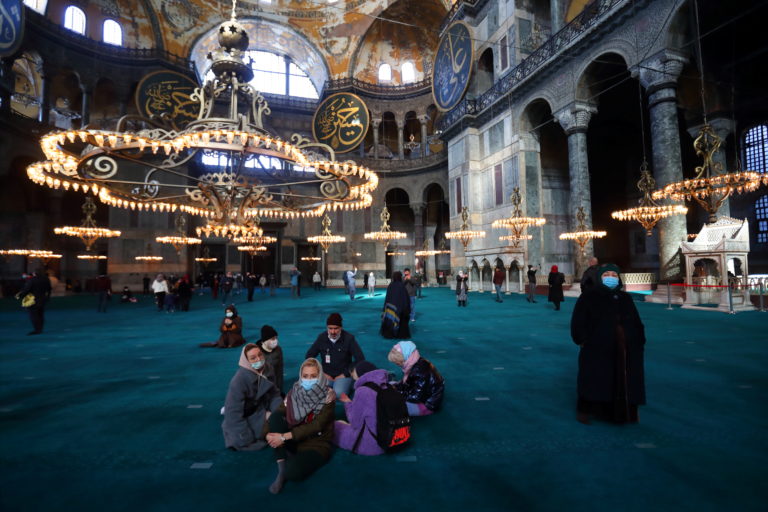
Russian tourists visit Ayasofya-i Kebir Camii or Hagia Sophia Grand Mosque, Istanbul, Turkey, January 29, 2021. Murad Sezer/Reuters
The Hagia Sophia, built between 534 and 537, functioned as a church until 1453, when it was converted to a mosque by Sultan Mehmed II with the Ottoman conquest of Constantinople. It remained a mosque until 1934, when the Republic of Turkey declared the building a museum.
The varied and layered history of the Hagia Sophia has led to a range of different interpretations of its significance. Some observers are inclined to see it as primarily a Byzantine and Christian monument, emphasizing its origins and life up until 1453 and viewing all later developments as irrelevant for its architectural and cultural history. On the other hand, those who see Hagia Sophia as primarily an Ottoman Islamic monument emphasize the transformative nature of the Ottoman conquest. They see its Byzantine past as the prehistory of the building, which ended with its spiritual transmutation. Beyond these opposing narratives of origin versus conversion, those who advocate for the building’s museum status—including a majority of the academic and cultural heritage community—also seem to prioritize the monument’s Christian character and mosaics, while only superficially addressing the building’s Ottoman layers.
Ideally, the multiple pasts of Hagia Sophia—church, mosque, museum—should be understood together in a narrative that encompasses the building’s entire history and the social, spiritual and cultural life of the building in all periods. Appreciation of its full history would also include an emphasis on its significance within the broader context of the Byzantine, Latin, Ottoman and modern Turkish eras. Looking at the situation of the Hagia Sophia alongside that of the Mosque-Cathedral of Córdoba in Spain provides a way to compare and contrast different strategies for managing the plural histories of monuments and to see how their history and architecture has been instrumentalized for national purposes. Complex structural and decorative changes were made to both buildings over time and both have been subject to decidedly modern methods of framing their pasts.
The Mosque-Cathedral of Córdoba
The Great Mosque of Córdoba was built in four phases of construction between 786 and 987 by the Umayyad rulers of al-Andalus.[1] The building was converted to a church in 1236, when Ferdinand III, King of Castile and León, conquered the city. It still has this function today but is also accessible to tourists between services, holds a small museum and is locally known as the Mezquita (mosque in Spanish). When Christians turned the mosque into a church, few changes were made initially.[2] The first major architectural intervention came around 1500 with the addition of a cathedral in the center of a prayer hall, which changed the building’s orientation to the east-west alignment desired for churches. From the exterior, this change is only visible in aerial photographs and from elevated locations. (Figure 1) Inside, the disruption is of a different nature. There are a few angles at which the viewer cannot see the added church and can enjoy an uninterrupted view of the mosque’s arches. (Figure 2) When entering the church section, however, the mosque completely disappears from view and the church dominates the space.
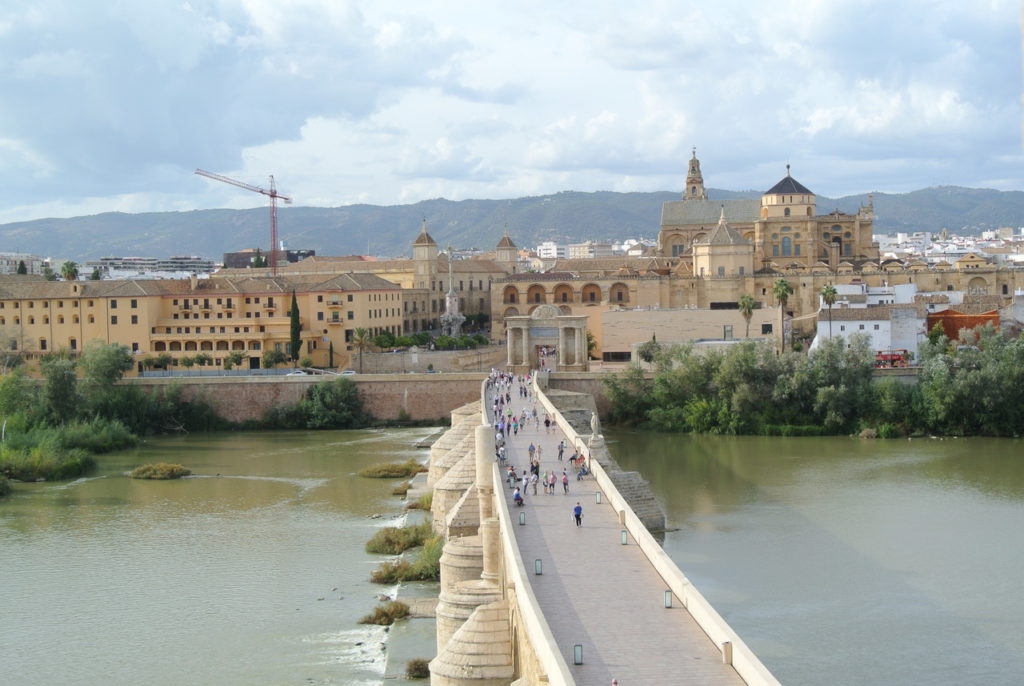
Figure 1: Exterior view of the Mosque-Cathedral of Córdoba. Patricia Blessing, 2015.
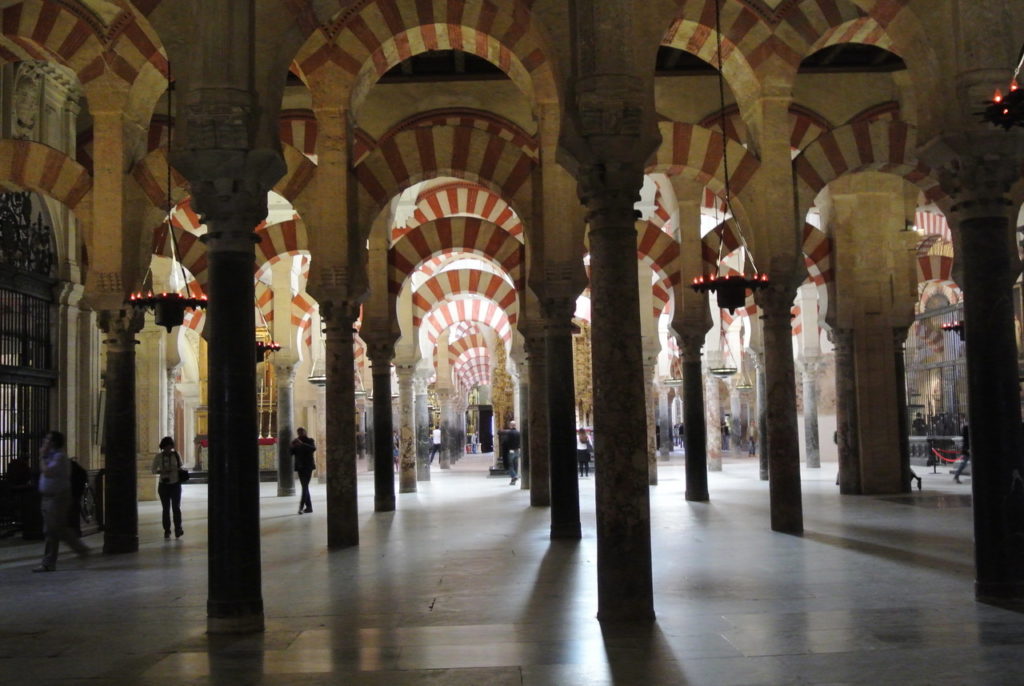
Figure 2: Interior the Mosque-Cathedral of Córdoba. Patricia Blessing, 2014.
How is the layered history of this building presented to visitors? The brochure available on site in 2014 and 2015, as well as the official website, tout a Christian-centric narrative. Created by the Cathedral Chapter, the local church authority that manages the building, the brochure was available in a number of languages (including Arabic) and states that a Visigothic church was destroyed for the mosque’s construction.[3] That claim, however, is not based on scientific evidence. Excavations conducted in the 1930s found no evidence of a church, only of late Roman residential buildings, results that were confirmed by further archaeological studies in the 1990s and in 2017.[4] Scientific evidence notwithstanding, the cathedral’s website and a plaque on site next to a window in the floor that offers a view of Roman relics below promote the idea that the Basilica of San Vincente was located there. The site’s role as a church—fictive in the pre-eigth-century past and actual from the thirteenth century to the present—takes center stage. This emphasis on its present function as a church is also reflected in the fact that in 2006 the Catholic Church registered the building as its property. A proposal created in the 1950s by architect Rafael Castejón to transform the monument into a museum was not pursued. Requests by Spanish Muslim communities for prayers to be held occasionally at the site have been rebuffed, and security guards are instructed to prevent Muslim visitors from praying.
The brochure goes on to describe the construction of the mosque as following the “Islamic invasion” of Córdoba. The notion that the culture of al-Andalus was the result of an Islamic invasion of Spain is one of the persistent themes of National Catholicism.[5] The brochure then turns to the thirteenth-century Christian takeover where the Church’s role in safeguarding the building is emphasized. This narrative, however, flattens the complexity of the building’s history in which “monarchs and clerics, Christians and Muslims alike, were protective, destructive, and transformative agents.”[6] Unlike Hagia Sophia, the Mosque-Cathedral of Córdoba was never secularized. Used as a mosque from its foundation in 786 until 1236, the building has served as a church ever since. None of the original mosque furniture has survived, and the oldest furnishings in the space are now altars, altarpieces and crucifixes added since the thirteenth century. Thus, while the structure itself is a hybrid monument in that both Muslim-built and Christian-built structures survive, its life as a mosque is difficult to imagine.
The Politics of Hagia Sophia’s Changing Status
What about the multiple lives of Hagia Sophia? Over time, the mihrab (a niche indicating the direction of Mecca), minbar (a pulpit from which sermons are given), four minarets and several mausolea were added to the structure and its surroundings. (Figure 3) In the interior, many mosaics remained visible until the seventeenth century, and some were still on view in the early eighteenth century. Scholars have carefully analyzed the timeline of these changes, including restoration of the mosaics by the Fossati brothers in 1847, after which they were once more covered. [7]
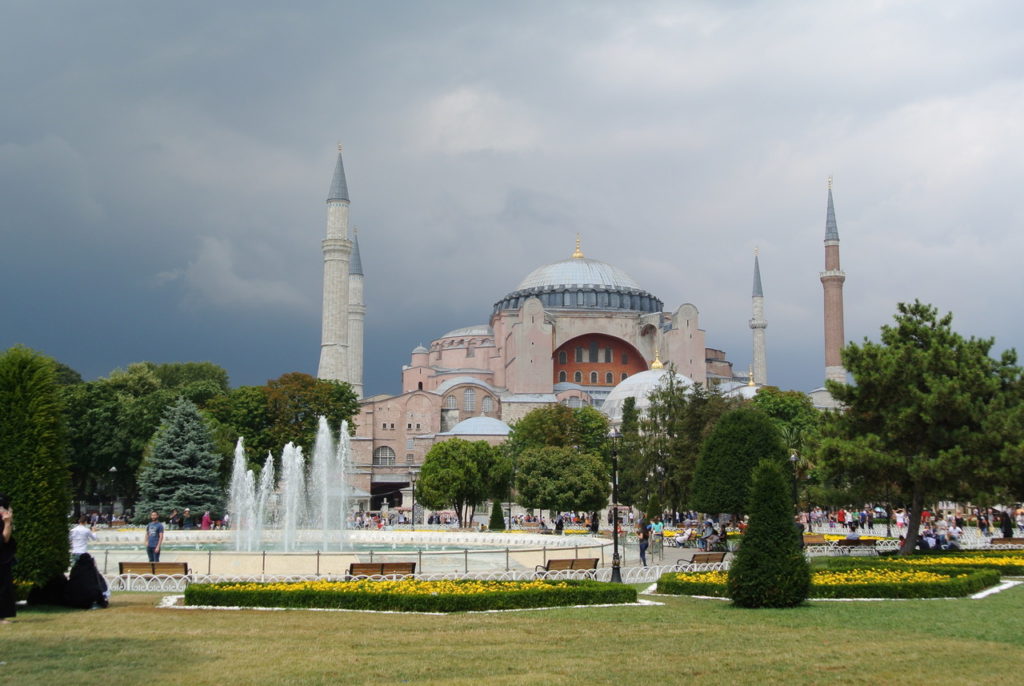
Figure 3: Exterior view of Hagia Sophia, Istanbul. Patricia Blessing, 2018.
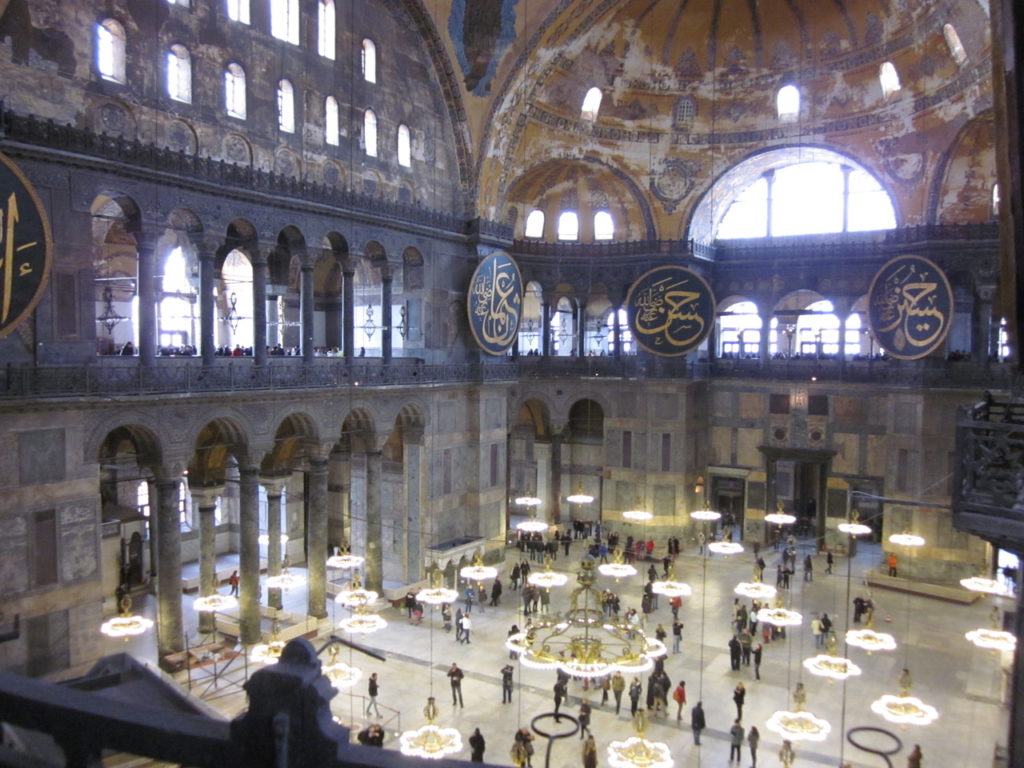
Figure 4: Interior view of Hagia Sophia as a museum, Istanbul. Patricia Blessing, 2011.
The decision to change Hagia Sophia from a museum back to a mosque did not come as a total surprise. In the 1930s, various groups had criticized the process of turning the structure into a museum on the grounds that its spiritual function would be lost. Beginning in the early 1950s, Hagia Sophia became a symbol for right-wing intellectuals and political groups in Turkey, from Islamists to conservatives and from Ottoman romantics to Turkish nationalists. They attacked the 1934 decision for different reasons: Some argued that it was part of the top-down, autocratic policies of the early republican regime, lacking in democratic consultation and harming the feelings of pious Muslims. Others blasted the decision by arguing that it was a concession to the West by a self-colonized, secular elite, which ignored Hagia Sophia’s deep spiritual and historical meaning. Still others saw the conversion to a museum as an attempt to resuscitate Byzantium in Istanbul—a theme that recurrently surfaced among Islamic nationalists, and even some Kemalists, in strong anti-Greek tones. These groups believed that the change in Hagia Sophia’s status alienated it from its historical and spiritual meaning as an icon of the Ottoman conquest of Constantinople, which had resulted in the building’s rebirth as one of the most sacred monuments of Islam. Right-wing politicians in Turkey presented the transformation of the monument into a museum not only as a symbol of a secular and patronizing educated social class but also as an attempt to revive the building’s Christian prehistory.[8]
The July 2020 decision was made under these circumstances. Instead of issuing a presidential decree, the Council of State cancelled the 1934 decision on the grounds that it violated waqf, or Islamic endowments, law. To justify the cancellation, the Council of State referred to decisions of the European Court of Human Rights (ECHR) that concerned illegitimate confiscations of waqf properties. Rıza Türmen (a former judge of ECHR) and Işıl Kurnaz, however, have made it clear that the Council of State’s decision cannot be understood through the lens of private law as in other waqf confiscation cases.[9] Rather, the 1453 waqf established for Hagia Sophia was an imperial foundation that, after the establishment of the Turkish Republic, falls within the scope of administrative law. Simply put, the 2020 decision prioritizes Ottoman-Islamic law over the administrative law of the Turkish Republic. It is not yet clear whether this decision will have further implications concerning waqf property and other legal matters, but it certainly raises concerns for the future of Hagia Sophia and other buildings that used to belong to Ottoman imperial waqfs. The potential consequences may be far reaching. The same is true for the fact that custodianship of Hagia Sophia was transferred from the Ministry of Culture and Tourism to the Presidency of Religious Affairs and the Directorate General of Endowments. Meanwhile, in an attempt to avoid polarization, opposition parties did not openly criticize the decision.
The Reopening of Hagia Sophia as a Mosque
There are some early indications of how the authorities intend to represent Hagia Sophia to the Turkish (and perhaps global) public. Some clues can be gleaned from an analysis of the first Friday sermon held at Hagia Sophia in 86 years, read by Ali Erbaş, head of the Presidency of Religious Affairs, on July 24, 2020. Erbaş, who stood on the minbar while holding a sword, suggesting conquest, started his sermon with a hadith: “Verily you shall conquer Constantinople. What a wonderful leader will he [the conqueror] be, and what a wonderful army will that army be!” The Ottoman conquest, Erbaş continued, was epitomized in the waqf deed of the city’s conqueror, Sultan Mehmed II, which stipulated that Hagia Sophia would be a mosque. As waqf deeds are considered eternal and unchangeable under Islamic law, this decision was, he suggested, permanent.
Further, Erbaş stated that in becoming a mosque, Hagia Sophia returned to its “original” character. Erbaş implied that the Hagia Sophia’s conversion to a mosque was an ontological shift that changed the building’s essence, akin to a human being’s religious conversion. One converts and is reborn as a Muslim. The convert’s earlier life is rendered irrelevant and sins disappear. Hagia Sophia’s conversion is similar in Erbaş’s view: The building was reborn in 1453, therefore, its pre-1453 life became void. In an earlier press release, Erbaş expressed his joy that Hagia Sophia had “returned to its essence.”
According to Erbaş, the conversion was an emotional process: As a museum, Hagia Sophia was sad and melancholic, stripped of its real identity, as well as of its people and its congregation. Now, Hagia Sophia had not only returned to its real identity but had also been reunited with its people. Thus, Erbaş anthropomorphized the monument. Its transformation from a church to a mosque in 1453 was a religious conversion with divine support and happened in accordance with Hagia Sophia’s own wishes. Consequently, turning the building into a museum in 1934 caused deep despair to this inherently Islamic monument. The sermon implied that in becoming a museum, the building was stripped of its Islamic dress (the carpets) and became not only sad but naked and ashamed. The newly uncovered mosaics, according to this narrative, were remnants of a prehistory that the building had voluntarily forgotten. By becoming a mosque once more, the building recovered not only its real self but also its appearance. Erbaş concluded his sermon with a universal message: he said that the doors of Hagia Sophia are open to all people, regardless of belief, language and color.
Lost Opportunities
Despite the Ottoman-centric narrative of Erbaş’s sermon, it is still possible for the authorities to do justice to Hagia Sophia’s complex architectural, artistic, historical and spiritual heritage. Information panels or interactive screens might be added that explain the site’s complex history, and some information, including the soundscapes of Hagia Sophia, could be included in audio-guides. Preservation of all of the site’s historical features—from mosaics to minarets—should continue in collaboration with local and international heritage professionals to ensure Hagia Sophia’s integrity.
In a further sign of the government’s approach, most of the mosaics have been covered with curtains that are not open between prayer times as initially promised. The galleries are currently closed for restoration, and it remains to be seen what will happen to the mosaics located there once (or if) these spaces are reopened. Also uncertain is the future ability of scholars to study the mosaics: Will it be possible to open the curtains for research appointments, or will practical complications from the scaffolding necessary to access them—and subsequent inconvenience for worshipers—be cited as reasons not to allow such visits? Will scholars who are not Turkish citizens still be able to secure research permits, given that these are normally handled by the Ministry of Culture and Tourism, which no longer has authority over Hagia Sophia?
The answers to these questions are unknown but there are similar concerns in the case of the Kariye Camii (also known as Chora Church) in Istanbul, which the government announced would be converted from a museum into an active mosque just weeks after Hagia Sophia. Problems related to preservation abound: What long-term damage might the fourteenth-century mosaics and wall paintings suffer from the curtain system that has been installed? Looming large are also the economic consequences for the neighborhood, which is remote from the mass tourism of the area between the Grand Bazaar and Hagia Sophia and will now pull in even fewer tourists.
Access for Turkish and international visitors varies depending on whether a structure is a museum or a mosque. Now that Hagia Sophia is an active mosque, prayer times and requirements for women to veil restrict access. But the museum was also a restricted space given that it required queuing for tickets and payment. While some critics argue that museums can be intimidating symbols of a secular, educated elite, it is worth pointing out that the Müzekart program allows Turkish citizens (and foreigners with a valid residence permit) access to more than 300 museums and archaeological sites in Turkey and Northern Cyprus for a modest yearly fee. Looking at museums across Istanbul, the two most popular sites with AKP voters are Topkapı Palace and Panorama 1453, a diorama of the Ottoman conquest of Constantinople.[10]
The huge rise in popularity of Hagia Sophia among certain groups after its conversion back to a mosque suggests that which sites get visited, and by whom, is a reflection of political and social polarization in today’s Turkey. Examining the presentation and legal status of the Mosque-Cathedral of Córdoba and Hagia Sophia reveals how political and religious authorities prioritize and inflate certain historical dimensions and narratives while minimizing or omitting others. In both cases authorities invented traditions in order to use the monuments in larger political and religious debates and polemics, and in the process they have limited the potential for a wider public to appreciate the richness of their full histories and the complexity of their multiple lives.
[Patricia Blessing is assistant professor of Islamic art history at Princeton University. Ali Yaycıoğlu is associate professor of Ottoman and Middle East history at Stanford University.]
Endnotes
[1] Nouha N. N. Khoury, “The Meaning of the Great Mosque of Córdoba in the Tenth Century,” Muqarnas 13 (1996).
[2] Heather Ecker, “The Great Mosque of Córdoba in the Twelfth and Thirteenth Centuries,” Muqarnas 20 (2003).
[3] Brain Rosa and Jaime Jover-Báez, “Contested Urban Heritage: Discourses of Meaning and Ownership of the Mosque-Cathedral of Córdoba, Spain,” Journal of Urban Cultural Studies 4, 1/2 (2017).
[4] Fernando Arce Sainz, “¿Hubo un precedente cristiano en el origen de la mezquita de Córdoba?” Al-Andalus y la Historia, December 20, 2019.
[5] Alejandro García Sanjuán, “La persistencia del discurso nacionalcatólico sobre el medievo peninsular en la historiografía española actual / The Persistence of National-Catholic Discourse on Medieval Iberia in Current Spanish Historiography,” Historiografías, revista de historia y teoría 12 (July-December 2016).
[6] Ecker, “The Great Mosque of Córdoba,” p. 115.
[7] Gülru Necipoğlu, “The Life of an Imperial Monument: Hagia Sophia after Byzantium,” in Robert Mark and Ahmet Cakmak, eds. Hagia Sophia: From the Age of Justinian to the Present (London: Cambridge University Press, 1992).
[8] Türk Millyetçileri Derneği İstanbul Şubesi, Ayasofya (Istanbul, April 18, 1952); Fetih ve Ayasofya: Buğun Gazetesinin Müslüman Türk Milletine Armağanı (May 29, 1970); İlker Aytürk, “Nationalism and Islam in Cold War Turkey, 1944–49,” Middle East Studies 50/5 (2014).
[9] Rıza Türmen and Işıl Kurnaz, “Bir Hukuk Bulmacası: Ayasofya Müze mi, Cami mi?,” T24, July 18, 2020.
[10] Gönül Bozoğlu, “‘A Great Bliss to Keep the Sensation of Conquest Alive!’ The Emotional Politics of the Panorama 1453 in Istanbul,” in Chiara de Cesari and Ayhan Kaya eds. European Memory of Populism: Representations of Self and Other (New York: Routledge, 2020).
